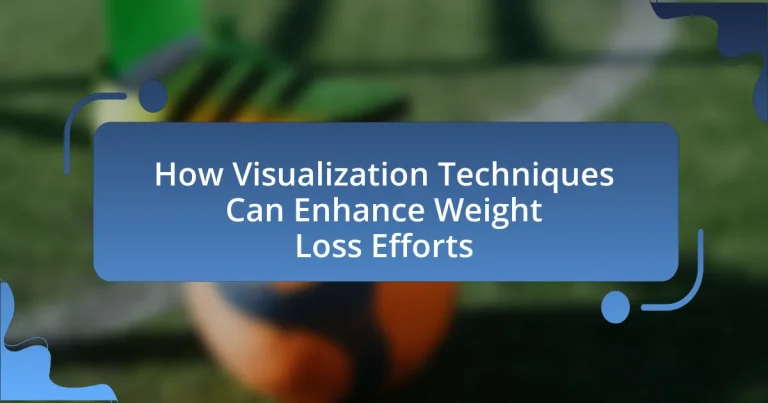Visualization techniques are mental imagery practices that aid individuals in achieving weight loss goals by enhancing motivation and commitment. These techniques, which include mental imagery, vision boards, and guided visualization, activate brain regions similar to actual experiences, reinforcing positive behaviors and self-efficacy. Research indicates that consistent practice of visualization can lead to improved adherence to diet and exercise regimens, making it an effective strategy for overcoming weight loss plateaus and fostering a positive mindset. The article explores the psychological principles underlying these techniques, their effectiveness compared to traditional weight loss methods, and practical steps for integrating visualization into daily routines.

What are Visualization Techniques in Weight Loss?
Visualization techniques in weight loss involve mental imagery practices that help individuals envision their goals, such as achieving a desired body shape or weight. These techniques can enhance motivation and commitment to weight loss efforts by creating a clear mental picture of success, which has been shown to improve focus and adherence to diet and exercise plans. Research indicates that visualization can activate the same brain regions as actual physical experiences, reinforcing the belief in one’s ability to achieve weight loss goals.
How do visualization techniques influence weight loss efforts?
Visualization techniques significantly enhance weight loss efforts by improving motivation and adherence to dietary and exercise regimens. Research indicates that individuals who regularly practice visualization are more likely to set and achieve specific weight loss goals, as they create mental images of their desired outcomes, which reinforces positive behaviors. A study published in the Journal of Consulting and Clinical Psychology found that participants who engaged in visualization exercises lost more weight compared to those who did not, highlighting the effectiveness of mental imagery in promoting sustained lifestyle changes.
What psychological principles underlie visualization techniques?
Visualization techniques are grounded in several psychological principles, primarily the concepts of mental imagery, self-efficacy, and cognitive behavioral theory. Mental imagery allows individuals to create vivid mental representations of desired outcomes, which can enhance motivation and focus. Self-efficacy, defined by Albert Bandura, refers to an individual’s belief in their ability to succeed in specific situations; higher self-efficacy can lead to greater persistence and effort in achieving weight loss goals. Cognitive behavioral theory posits that changing thought patterns can influence behaviors; visualization can help reframe negative thoughts about weight loss into positive, achievable goals. These principles collectively support the effectiveness of visualization in enhancing weight loss efforts by fostering a positive mindset and reinforcing goal-oriented behaviors.
How do visualization techniques differ from other weight loss methods?
Visualization techniques differ from other weight loss methods by focusing on mental imagery to enhance motivation and adherence to weight loss goals. Unlike traditional methods that often emphasize physical activity and dietary restrictions, visualization techniques involve creating vivid mental images of desired outcomes, which can lead to increased self-efficacy and commitment. Research indicates that mental imagery can activate similar brain regions as actual experiences, thereby reinforcing positive behaviors and attitudes towards weight loss. For instance, a study published in the Journal of Consulting and Clinical Psychology found that participants who used visualization techniques reported greater weight loss success compared to those who did not, highlighting the effectiveness of this approach in fostering a positive mindset and behavioral change.
Why are visualization techniques effective for weight loss?
Visualization techniques are effective for weight loss because they enhance motivation and reinforce positive behaviors. By mentally picturing desired outcomes, individuals can create a strong emotional connection to their weight loss goals, which has been shown to increase commitment and persistence. Research indicates that visualization can activate the same brain regions as actual experiences, making the goals feel more attainable and real. For instance, a study published in the Journal of Consulting and Clinical Psychology found that participants who used visualization techniques reported greater weight loss success compared to those who did not. This demonstrates that visualization not only aids in goal setting but also in maintaining focus and determination throughout the weight loss journey.
What role does motivation play in visualization for weight loss?
Motivation is crucial in visualization for weight loss as it drives the commitment to maintain consistent practice and adherence to goals. When individuals visualize their desired outcomes, such as achieving a specific weight or body shape, their motivation reinforces the mental imagery, making the goals feel more attainable. Research indicates that motivated individuals are more likely to engage in positive behaviors, such as exercising and eating healthily, which are essential for weight loss. A study published in the journal “Health Psychology” by McCaffrey et al. (2016) found that participants who utilized visualization techniques alongside high motivation experienced greater weight loss compared to those with lower motivation levels. This evidence underscores the significant role motivation plays in enhancing the effectiveness of visualization techniques in weight loss efforts.
How can visualization techniques help in overcoming weight loss plateaus?
Visualization techniques can help in overcoming weight loss plateaus by enhancing motivation and reinforcing positive behaviors. When individuals visualize their goals, such as achieving a specific weight or body shape, they create a mental image that can increase their commitment to their weight loss journey. Research indicates that mental imagery can improve performance and adherence to fitness routines, as seen in a study published in the Journal of Sport & Exercise Psychology, which found that athletes who used visualization techniques showed improved outcomes in their training. By regularly practicing visualization, individuals can maintain focus on their objectives, thereby breaking through plateaus and continuing their weight loss progress.

What Types of Visualization Techniques Can Be Used for Weight Loss?
Visualization techniques that can be used for weight loss include mental imagery, vision boards, and guided visualization. Mental imagery involves vividly picturing oneself achieving weight loss goals, which can enhance motivation and commitment. Vision boards consist of visual representations of desired outcomes, such as images of healthy foods or fit bodies, serving as daily reminders of goals. Guided visualization involves listening to audio recordings that lead individuals through scenarios of successful weight loss, reinforcing positive behaviors and attitudes. Research indicates that these techniques can improve adherence to weight loss programs and increase overall effectiveness, as evidenced by studies showing that visualization can enhance self-efficacy and motivation in individuals pursuing weight loss.
How can guided imagery assist in weight loss efforts?
Guided imagery can assist in weight loss efforts by helping individuals visualize their goals and create a mental image of their desired body and lifestyle. This technique promotes relaxation and reduces stress, which can lead to healthier eating habits and increased motivation for physical activity. Research indicates that visualization can enhance self-efficacy, making individuals more likely to engage in behaviors that support weight loss. For example, a study published in the journal “Health Psychology” found that participants who practiced guided imagery reported greater weight loss and improved body image compared to those who did not use this technique.
What steps are involved in practicing guided imagery for weight loss?
Practicing guided imagery for weight loss involves several key steps. First, individuals should find a quiet and comfortable space to relax, minimizing distractions. Next, they should close their eyes and take deep breaths to enter a calm state. Following this, they visualize themselves achieving their weight loss goals, focusing on specific details such as their ideal body shape, the feelings associated with being at that weight, and engaging in healthy activities. It is important to incorporate positive affirmations during this visualization process to reinforce motivation and self-belief. Finally, individuals should gradually bring their awareness back to the present moment, reflecting on the imagery experienced and how it can influence their real-life actions. Research indicates that guided imagery can enhance motivation and self-efficacy, which are crucial for successful weight loss efforts.
How does guided imagery impact emotional eating?
Guided imagery significantly reduces emotional eating by helping individuals manage stress and emotional triggers. This technique involves visualizing calming and positive scenarios, which can lower anxiety levels and decrease the urge to eat in response to emotions. Research indicates that guided imagery can enhance self-regulation and mindfulness, leading to healthier coping mechanisms. A study published in the journal “Appetite” found that participants who practiced guided imagery reported lower levels of emotional eating compared to those who did not engage in such techniques, demonstrating its effectiveness in promoting healthier eating behaviors.
What is the role of vision boards in weight loss?
Vision boards play a significant role in weight loss by serving as visual reminders of goals and aspirations. They help individuals clarify their weight loss objectives, maintain motivation, and reinforce positive behaviors. Research indicates that visualization techniques, including the use of vision boards, can enhance goal achievement by activating the brain’s motivational pathways, which can lead to increased commitment to weight loss efforts. A study published in the Journal of Health Psychology found that participants who used visualization techniques, such as vision boards, reported higher levels of motivation and success in achieving their weight loss goals compared to those who did not utilize such tools.
How can creating a vision board enhance commitment to weight loss goals?
Creating a vision board enhances commitment to weight loss goals by providing a visual representation of desired outcomes, which reinforces motivation and focus. Research indicates that visualization techniques, such as vision boards, can significantly impact goal achievement by activating the brain’s reward system, making the goals feel more attainable. A study published in the Journal of Personality and Social Psychology found that individuals who visualize their goals are more likely to take actionable steps towards achieving them, as the imagery creates a sense of ownership and emotional connection to the goals. This emotional engagement can lead to increased persistence and resilience in the face of challenges, ultimately supporting sustained commitment to weight loss efforts.
What elements should be included in an effective weight loss vision board?
An effective weight loss vision board should include specific goals, motivational images, affirmations, and a timeline for achieving weight loss objectives. Specific goals provide clarity on desired outcomes, such as target weight or fitness milestones. Motivational images, such as pictures of healthy foods, fit individuals, or inspiring quotes, serve to reinforce commitment and visualize success. Affirmations, positive statements about one’s ability to lose weight and maintain a healthy lifestyle, help to cultivate a positive mindset. Lastly, a timeline establishes a sense of urgency and accountability, guiding the individual in tracking progress and staying focused on their weight loss journey.

How Can Visualization Techniques Be Integrated into a Weight Loss Plan?
Visualization techniques can be integrated into a weight loss plan by encouraging individuals to create mental images of their goals, such as achieving a desired weight or maintaining a healthy lifestyle. This method enhances motivation and commitment, as studies show that visualizing success can lead to improved performance and goal attainment. For instance, research published in the Journal of Consulting and Clinical Psychology indicates that individuals who engage in visualization techniques are more likely to adhere to their weight loss plans and achieve their targets. By incorporating regular visualization exercises, such as imagining oneself engaging in healthy eating or exercising, individuals can reinforce positive behaviors and maintain focus on their weight loss journey.
What are practical steps to incorporate visualization into daily routines?
To incorporate visualization into daily routines, individuals should begin by setting specific goals related to weight loss and then create vivid mental images of achieving those goals. This can be done by dedicating a few minutes each day to visualize oneself reaching the desired weight, engaging in healthy activities, and experiencing the emotions associated with success. Research indicates that visualization can enhance motivation and performance; for instance, a study published in the Journal of Sport & Exercise Psychology found that athletes who practiced visualization improved their performance significantly compared to those who did not. Additionally, integrating visualization into existing habits, such as visualizing during morning routines or while exercising, can reinforce the practice and make it a consistent part of daily life.
How often should visualization exercises be practiced for maximum effect?
Visualization exercises should be practiced daily for maximum effect. Consistent daily practice enhances the effectiveness of visualization by reinforcing mental imagery and increasing motivation, which are crucial for weight loss efforts. Research indicates that engaging in visualization techniques regularly can lead to improved outcomes in goal achievement, as seen in studies on athletes and performance enhancement. For instance, a study published in the Journal of Applied Sport Psychology found that athletes who practiced visualization daily experienced significant improvements in performance compared to those who did not. Therefore, daily practice is essential for optimizing the benefits of visualization in weight loss efforts.
What time of day is most effective for visualization exercises?
The most effective time of day for visualization exercises is typically in the morning. Research indicates that engaging in visualization techniques early in the day can enhance focus and motivation, which are crucial for weight loss efforts. A study published in the Journal of Applied Psychology found that individuals who practiced visualization in the morning reported higher levels of goal commitment and performance throughout the day. This suggests that morning visualization can set a positive tone for the day, making it an optimal time for such exercises.
What challenges might arise when using visualization techniques for weight loss?
Challenges that might arise when using visualization techniques for weight loss include unrealistic expectations, emotional distress, and lack of consistency. Unrealistic expectations can lead to disappointment if individuals do not see immediate results, which may discourage continued effort. Emotional distress can occur if individuals visualize themselves in a way that contrasts sharply with their current state, potentially leading to negative self-image and decreased motivation. Additionally, lack of consistency in practicing visualization can hinder its effectiveness, as regular reinforcement is necessary for the technique to influence behavior positively. Research indicates that visualization requires sustained practice to yield significant results, emphasizing the importance of commitment in overcoming these challenges.
How can individuals overcome skepticism about visualization techniques?
Individuals can overcome skepticism about visualization techniques by engaging in consistent practice and observing tangible results. Research indicates that visualization can enhance motivation and goal achievement, as evidenced by a study published in the Journal of Consulting and Clinical Psychology, which found that participants who used visualization techniques reported higher levels of self-efficacy and goal attainment. By integrating visualization into their weight loss efforts, individuals can track their progress and correlate their mental imagery with actual outcomes, reinforcing the effectiveness of these techniques.
What strategies can help maintain consistency in visualization practices?
To maintain consistency in visualization practices, individuals should establish a routine that incorporates regular visualization sessions. This routine can be reinforced by setting specific goals related to weight loss, such as visualizing achieving a target weight or fitting into a desired outfit. Research indicates that consistent practice enhances the effectiveness of visualization techniques, as seen in studies where participants who visualized their goals regularly reported higher motivation and commitment to their weight loss plans. Additionally, using visualization tools like vision boards or guided imagery can help reinforce these practices, making them more tangible and easier to integrate into daily life.
What are some best practices for effective visualization in weight loss?
Effective visualization in weight loss involves creating clear, specific mental images of desired outcomes and progress. Best practices include setting realistic goals, such as visualizing a target weight or body shape, which helps maintain motivation and focus. Additionally, using visual aids like charts or progress photos can reinforce commitment by providing tangible evidence of progress. Research indicates that individuals who engage in visualization techniques are more likely to achieve their weight loss goals, as these practices enhance self-efficacy and adherence to diet and exercise regimens.
How can individuals tailor visualization techniques to their personal goals?
Individuals can tailor visualization techniques to their personal goals by creating specific mental images that align with their desired outcomes, such as achieving a target weight or maintaining a healthy lifestyle. For instance, a person aiming to lose weight can visualize themselves engaging in healthy activities, like exercising or preparing nutritious meals, which reinforces positive behaviors and motivates action. Research indicates that visualization can enhance performance and goal attainment; a study published in the Journal of Sport & Exercise Psychology found that athletes who used visualization techniques improved their performance significantly compared to those who did not. By personalizing these techniques to reflect individual aspirations and incorporating vivid details, individuals can effectively enhance their weight loss efforts through focused visualization.
What common mistakes should be avoided when using visualization for weight loss?
Common mistakes to avoid when using visualization for weight loss include setting unrealistic goals, neglecting emotional engagement, and failing to create a consistent practice. Unrealistic goals can lead to disappointment and decreased motivation, as studies show that achievable targets enhance commitment. Neglecting emotional engagement means missing the opportunity to connect deeply with the desired outcome, which is crucial for effective visualization; research indicates that emotional involvement can significantly boost motivation and adherence to weight loss plans. Lastly, inconsistency in practice undermines the effectiveness of visualization techniques; regular engagement is essential for reinforcing mental imagery and achieving desired results.


